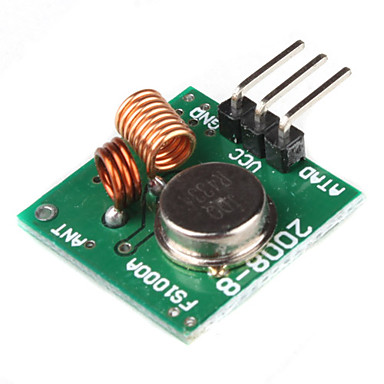433 MHz Sendemodul
Das 433 MHz Sendemodul
Die kleinen Sende und Empfangsmodule für das ehemalige Amateurfunkband 433MHz (= 70 cm) sind meist paarweise bei Ebay und noch mehr in China für sehr kleines Geld erhältlich. Üblicherweise werden die Module aber ohne Antenne geliefert, weshalb man ein 17,5 cm langes möglichst nicht zu dünnen Stück Kupferdraht ein die vorhandene Bohrung einlöten muss. Ich habe einen 1 mm starken Kupferlackdraht genommen und bin sehr zufrieden mit dem Ergebnis (den Lack muss man natürlich am zu verlötenden Ende abschaben.)
Es sei aber an dieser Stelle nochmal erwähnt dass es mir nicht gelungen ist, beie Module gleichzeitig, also im Transceiverbetrieb zum Laufen zu bringen. Das scheint an der VirtualWire Library zu liegen, die darauf wohl nicht ausgelegt ist.
Anschluss
| Arduino | Modul |
|---|---|
| 5V | Vcc |
| GND | - |
| Pin 8 | Data (beschriftet „Atad |
Beispielcode
#include <VirtualWire.h> // you must download and install the VirtualWire.h to your hardware/libraries folder
#undef int
#undef abs
#undef double
#undef float
#undef round
void setup()
{
Serial.begin(9600);
// Initialise the IO and ISR
vw_set_ptt_inverted(true); // Required for RX Link Module
vw_setup(2000); // Bits per sec
vw_set_tx_pin(7); // pin 3 is used as the transmit data out into the TX Link module,
vw_rx_start(); // Start the receiver
}
void loop()
{
uint8_t buf[VW_MAX_MESSAGE_LEN];
uint8_t buflen = VW_MAX_MESSAGE_LEN;
Serial.println("Senden: ");
delay(10);
const char *msg = "+++++++++ Nachricht +++++++++++"; // this is your message to send
vw_send((uint8_t *)msg, strlen(msg));
vw_wait_tx(); // Wait for message to finish
delay(500);
}- Zugriffe: 735
